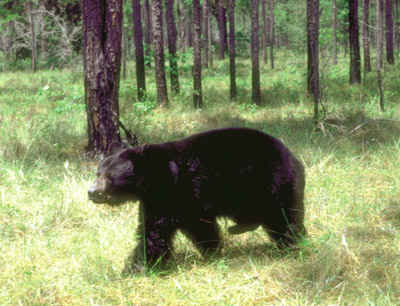Florida Black Bear
 Ursus americanus floridanus
Ursus americanus floridanus
"Are there really bears in Florida?"
In fact, an estimated 1,500 Florida black bears remain from a population once thought to number 12,000. They historically ranged throughout the state and into southern Georgia and Alabama. Currently the five major populations are found in the Ocala, Apalachicola and Osceola National Forests in northern and central Florida, the Eglin Air Force Base and Blackwater State Forest complex in the Florida panhandle and the Big Cypress Swamp in south Florida. See map
The black bear subspecies is perhaps the strongest symbol for Florida's diverse wildlife. A wide-ranging omnivore, the bear shares habitat with many of Florida's other native species. By
protecting the bear and its habitat, conservationists also support many other animals and plants.
- The Florida black bear is black with a brown muzzle. Some have a white "blaze" on their chests.
- An average male black bear weighs 350 pounds, while a female averages 150 pounds.
- Forest habitats, both wetland and upland forests, are the primary homes of the Florida black bear.
- The average home range of an adult female black bear is about 11 square miles; a male's can approach 66 square miles.
- The Florida black bear's diet is 80 percent vegetable matter. Foods include berries, acorns, insects and palmetto hearts. Occasionally they eat armadillos and carrion.
- Females give birth to their cubs in dens, which may be in a hollow, standing tree or on the ground in remote thickets or swamps. A mother black bear and her cubs will stay together for a year and a half.
- Upon maturity, the female offspring remain in their mother's home range. Males disperse and travel to a new area to establish their own breeding territory. As males disperse, they often cross roads and are vulnerable to being hit by cars and trucks.

- An estimated 12,000 bears once roamed the area that is now Florida. Approximately 1,000 to 1,500 Florida black bears survive today.
- The black bear is listed as a threatened species by the state of Florida. It is a candidate for listing as endangered or threatened under the federal Endangered Species Act. Under a court settlement with Defenders of Wildlife and others, the U.S. Fish and Wildlife Service must make a decision on the bear's status by December 31, 1998.
- A healthy bear population needs at least 400,000 acres to survive. To protect an area of this size in highly developed Florida often requires preserving connections between core habitats.
- The black bear is considered an umbrella species by biologists because it is such a wide-ranging species. By protecting bears and their habitat, we also protect many other plant and animal species, including the endangered Florida scrub jay and the eastern indigo snake.
- The leading threats to the bear include land development, highway construction and roadkills. More than 50 bears are killed on Florida roads each year.
- No human has ever been killed by a Florida black bear.
Images ©Florida Fish and Wildlife Conservation Commission
Selected Animals | Alligator | Black Bear | Bobcat | Key Deer | Manatee | Panther | Selected Birds of Florida
Kick n' Back |Navy Links | Misc. Links | Illinois Civil War Units | Personal Info | Florida | Early Origins | Special Place | La Florida
This page hosted byGeoCities.
Get your own Free Home Page
Site© 1996-2004
 Ursus americanus floridanus
Ursus americanus floridanus Ursus americanus floridanus
Ursus americanus floridanus